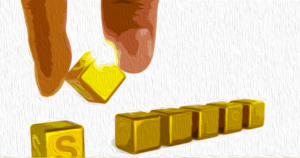
Introduction
Institutional investors looking to earn rewards from digital asset token staking must be aware of the associated risks and take steps to protect their clients. Andrew McFarlane, the CTO at Validation Cloud, a Web3 infrastructure company, emphasizes the importance of understanding these risks and implementing measures to mitigate them.
The Risk of Slashing
One of the key risks that asset managers must be aware of is slashing. Slashing is a penalty imposed on tokens staked on a validator who violates the rules of the network. To minimize the chances of being affected by a rogue validator, asset managers should choose a validator with relevant experience. McFarlane suggests that asset managers should engage staking-as-a-service providers that offer strong security measures and slashing insurance.
The Importance of Audited Staking Platforms
To assure their clients that their chosen staking-as-a-service provider is reputable, asset managers can opt for an audited staking platform. These platforms receive either SOC2 Type 1 or Type 2 attestation reports. McFarlane believes that SOC2 Type 1 is a better attestation report, although both are valuable.
The Ethereum Network's Staking Ratio
When asked about the low staking ratio on the Ethereum network, McFarlane explains that this is due to the complete staking mechanism being implemented after the Shapella upgrade in April. Since then, there has been a significant growth of over 50% in staked Ethereum in the last six months.
The Benefits of Staking-as-a-Service
The Staking-as-a-Service product allows asset managers to support blockchain network operations without the burden of launching and maintaining the necessary infrastructure. In return, asset managers can earn significant rewards generated by the network. The defining characteristic of a Staking-as-a-Service solution is the ability to provide this service without taking custody of the tokens, unlike protocols that require asset managers to deposit funds into their systems before staking.
Meeting Institutional Obligations with Staking-as-a-Service
Institutional asset managers have strict obligations to hold assets with qualified custodians and work with tech partners who are SOC2-compliant. Staking-as-a-Service uniquely satisfies these obligations by allowing asset managers to keep their tokens in a custodian while being serviced by secure and compliant infrastructure.
Understanding Slashing Risks in Proof of Stake Networks
The main risk in Proof of Stake (PoS) networks is slashing, which refers to the penalty imposed on tokens staked on a validator who violates the rules of the network. Validators may face slashing if they propose multiple blocks (double signing), propose invalid blocks, or experience prolonged downtime. While such events are rare, engaging experienced Staking-as-a-Service providers with strong preventative and corrective measures can significantly reduce this risk.
Validation Cloud's Institutional Focus
Validation Cloud's platform is purpose-built to cater to institutional assets. The company anticipates a rapid influx of large asset managers into the Web3 space, with over a trillion dollars in assets staked in the near future. To facilitate this growth, Validation Cloud needs 1.5 million additional validators to support the next $100 million in staked Ethereum. The company also prioritizes real-time infrastructure and rewards automation, driving a superior experience and performance for asset managers.
The Importance of SOC2 Compliance
Validation Cloud recognizes the criticality of compliance for institutional asset managers and traditional enterprises. The company completed its SOC2 audit with Sensiba LLP in August, making it one of the few Web3 companies to achieve SOC2 compliance. SOC2 compliance is pivotal in aligning industry standards with those of traditional enterprises and bridging the gap between Web2 and Web3.
The Difference Between SOC2 Type 1 and Type 2
SOC2 defines criteria for managing customer data, including security, availability, integrity, confidentiality, and privacy. The main difference between SOC2 Type 1 and Type 2 lies in the duration of evaluation. Type 1 focuses on security controls at a specific point in time, while Type 2 covers those controls over a period, typically several months. Validation Cloud's Type 2 observation period will conclude at the end of 2023.
The Growth of Staked Ethereum After the Shapella Upgrade
Before the Shapella upgrade, it was impossible to unstake Ethereum, limiting its staking ratio. However, after the upgrade, there has been a significant growth of over 50% in staked Ethereum in the last six months. The Shapella upgrade marked an inflection point for institutional asset managers, enabling them to actively participate in staking.
Conclusion
As institutional investors venture into digital asset token staking, it is crucial for them to understand the associated risks and take necessary precautions. By choosing experienced validators, utilizing audited staking platforms, and engaging reliable Staking-as-a-Service providers, asset managers can navigate the staking landscape with confidence and maximize their rewards.
What are your thoughts on digital asset token staking for institutional investors? Share your opinions in the comments section below.
Frequently Asked Questions
What's the advantage of a Gold IRA?
There are many advantages to a gold IRA. It's an investment vehicle that lets you diversify your portfolio. You decide how much money you want to put into each account, and when you want it to be withdrawn.
You also have the option to roll over funds from other retirement accounts into a gold IRA. This will allow you to transition easily if it is your decision to retire early.
The best part? You don’t need to have any special skills to invest into gold IRAs. They're available at most banks and brokerage firms. Withdrawals are made automatically without having to worry about fees or penalties.
There are, however, some drawbacks. Gold has historically been volatile. So it's essential to understand why you're investing in gold. Is it for growth or safety? Are you looking for growth or insurance? Only once you know, that will you be able to make an informed decision.
If you plan on keeping your gold IRA alive for a while, you may want to consider purchasing more than 1 ounce of pure gold. A single ounce will not be sufficient to meet all your requirements. You could need several ounces depending on what you plan to do with your gold.
If you're planning to sell off your gold, you don't necessarily need a large amount. You can even manage with one ounce. But you won't be able to buy anything else with those funds.
How much should precious metals be included in your portfolio?
This question can only be answered if we first know what precious metals are. Precious metals have elements with an extremely high worth relative to other commodity. This makes them very valuable in terms of trading and investment. Today, gold is the most commonly traded precious metal.
There are however many other types, including silver, and platinum. The price for gold is subject to fluctuations, but stays relatively stable in times of economic turmoil. It also remains relatively unaffected by inflation and deflation.
As a general rule, the prices for all precious metals tend to increase with the overall market. That said, they do not always move in lockstep with each other. For instance, gold's price will rise when the economy is weak, while precious metals prices will fall. Investors expect lower interest rate, making bonds less appealing investments.
Contrary to this, when the economy performs well, the opposite happens. Investors are more inclined to invest in safe assets, such as Treasury Bonds, and they will not demand precious metals. Because they are rare, they become more pricey and lose value.
You must therefore diversify your investments in precious metals to reap the maximum profits. Furthermore, because the price of precious Metals fluctuates, it is best not to focus on just one type of precious Metals.
How Much of Your IRA Should Include Precious Metals?
When investing in precious metals, the most important thing to know is that they aren't just for wealthy people. They don't require you to be wealthy to invest in them. In fact, there are many ways to make money from gold and silver investments without spending much money.
You might think about buying physical coins such a bullion bar or round. Also, you could buy shares in companies producing precious metals. Another option is to make use of the IRA rollover programs offered by your retirement plan provider.
You will still reap the benefits of owning precious metals, regardless of which option you choose. Although they aren’t stocks, they offer the possibility for long-term gains.
And unlike traditional investments, they tend to increase in value over time. If you decide to sell your investment, you will likely make more than with traditional investments.
What are some of the advantages and disadvantages to a gold IRA
An Individual Retirement Plan (IRA) has a major advantage over regular savings accounts. It doesn't tax any interest earned. An IRA is a great way to save money and not have to pay taxes on the interest you earn. There are some disadvantages to this investment.
For example, if you withdraw too much from your IRA once, you could lose all your accumulated funds. You may also be prohibited by the IRS from making withdrawals from an IRA after you turn 59 1/2. A penalty fee will be charged if you decide to withdraw funds.
A disadvantage to managing your IRA is the fact that fees must be paid. Many banks charge between 0.5% and 2.0% per year. Other providers charge monthly management fees ranging from $10 to $50.
Insurance will be required if you would like to keep your cash out of banks. A majority of insurance companies require that you possess a minimum amount gold to be eligible for a claim. It is possible that you will be required to purchase insurance that covers losses of up to $500,000.
If you choose to go with a gold IRA, you'll need to determine how much gold you want to use. Some providers limit the amount of gold that you are allowed to own. Others let you choose your weight.
It is also up to you to decide whether you want to purchase physical gold or futures. Gold futures contracts are more expensive than physical gold. However, futures contracts give you flexibility when buying gold. They allow you to set up a contract with a specific expiration date.
It is also important to choose the type of insurance coverage that you need. The standard policy doesn’t provide theft protection or loss due fire, flood, or earthquake. It does include coverage for damage due to natural disasters. You might consider purchasing additional coverage if your area is at high risk.
You should also consider the cost of storage for your gold. Storage costs are not covered by insurance. For safekeeping, banks typically charge $25-40 per month.
To open a IRA in gold, you will need to first speak with a qualified custodian. A custodian maintains track of all your investments and ensures you are in compliance with federal regulations. Custodians cannot sell your assets. Instead, they must retain them for as long and as you require.
After you've determined which type of IRA is best for you, fill out the paperwork indicating your goals. You should also include information about your desired investments, such as stocks or bonds, mutual funds, real estate, and mutual funds. It is also important to specify how much money you will invest each month.
Once you have completed the forms, you will need to mail them to your provider with a check and a small deposit. The company will review your application and send you a confirmation letter.
You should consult a financial planner before opening a Gold IRA. A financial planner is an expert in investing and can help you choose the right type of IRA for you. They can help reduce your expenses by helping you find cheaper alternatives to buying insurance.
Should You Invest in gold for Retirement?
The answer will depend on how many dollars you have saved so far and whether you had gold as an investment option at the time. You can invest in both options if you aren't sure which option is best for you.
In addition to being a safe investment, gold also offers potential returns. Retirement investors will find gold a worthy investment.
Gold is more volatile than most other investments. This causes its value to fluctuate over time.
However, it doesn't necessarily mean that you shouldn't invest your money in gold. Instead, it just means you should factor the fluctuations into your overall portfolio.
Another benefit of gold is that it's a tangible asset. Gold is more convenient than bonds or stocks because it can be stored easily. It's also portable.
As long as you keep your gold in a secure location, you can always access it. You don't have to pay storage fees for physical gold.
Investing in gold can help protect against inflation. Gold prices are likely to rise with other commodities so it is a good way of protecting against rising costs.
Additionally, it will be a benefit to have some of your savings invested into something that won't lose value. When the stock market drops, gold usually rises instead.
Another benefit to investing in gold? You can always sell it. Like stocks, you can sell your position anytime you need cash. You don't have to wait for retirement.
If you do decide to invest in gold, make sure to diversify your holdings. You shouldn't try to put all of your eggs into one basket.
Do not buy too much at one time. Start small, buying only a few ounces. Continue adding more as necessary.
It's not about getting rich fast. Instead, the goal is to accumulate enough wealth that you don't have to rely on Social Security.
Although gold might not be the right investment for everyone it could make a great addition in any retirement plan.
Statistics
- Gold is considered a collectible, and profits from a sale are taxed at a maximum rate of 28 percent. (aarp.org)
- Indeed, several financial advisers interviewed for this article suggest you invest 5 to 15 percent of your portfolio in gold, just in case. (aarp.org)
- The price of gold jumped 131 percent from late 2007 to September 2011, when it hit a high of $1,921 an ounce, according to the World Gold Council. (aarp.org)
- Instead, the economy improved, stocks rebounded, and gold plunged, losing 28 percent of its value in 2013. (aarp.org)
- Contribution limits$6,000 (49 and under) $7,000 (50 and up)$6,000 (49 and under) $7,000 (50 and up)$58,000 or 25% of your annual compensation (whichever is smaller) (lendedu.com)
External Links
bbb.org
wsj.com
- Saddam Hussein's Invasion Helped Uncage a Bear In 1990 – WSJ
- How do you keep your IRA Gold at Home? It's Not Exactly Legal – WSJ
forbes.com
investopedia.com
How To
The History of Gold as an Asset
From the beginning of history, gold was a popular currency. It was universally accepted and loved for its beauty, durability, purity and divisibility. In addition, because of its value, it was traded internationally. Different weights and measurements existed around the world, however, because there were not international standards to measure gold. One pound sterling, for example, was equivalent in England to 24 carats, and one livre tournois, in France, to 25 carats. A mark, on the other hand, was equivalent in Germany to 28 carats.
In the 1860s, the United States began to issue American coins made from 90% copper, 10% Zinc, and 0.942 Fine Gold. This resulted in a decline of foreign currency demand and an increase in the price. The United States began minting large quantities gold coins at this time, which led to a drop in the price. Because the U.S. government had too much money coming into circulation, they needed to find a way to pay off some debt. They decided to sell some excess gold to Europe in order to do this.
Many European countries didn't trust the U.S. dollars and started to accept gold for payment. After World War I, however, many European countries started using paper money to replace gold. The value of gold has significantly increased since then. Even though the price of gold fluctuates, it remains one the best investments you can make.
—————————————————————————————————————————————————————————————–
By: Terence Zimwara
Title: Understanding the Risks and Rewards of Digital Asset Token Staking for Institutional Investors
Sourced From: news.bitcoin.com/asset-managers-should-only-engage-staking-platforms-with-strong-security-andrew-mcfarlane/
Published Date: Sun, 03 Dec 2023 12:30:45 +0000
Related posts:
 Crypto Exchange Kraken Backs Enterprise-Grade Liquid Staking Protocol
Crypto Exchange Kraken Backs Enterprise-Grade Liquid Staking Protocol
 Proof-of-Work Proponents Question Validator Censorship as 59% of Staked Ethereum Is Held by 4 Companies
Proof-of-Work Proponents Question Validator Censorship as 59% of Staked Ethereum Is Held by 4 Companies
 7 Best Gold IRA Companies 2023 (Ranked by customer reviews)
7 Best Gold IRA Companies 2023 (Ranked by customer reviews)
 30% of Today’s Staked Ethereum Is Tied to Lido’s Liquid Staking, 8 ETH 2.0 Pools Command $8.1 Billion in Value
30% of Today’s Staked Ethereum Is Tied to Lido’s Liquid Staking, 8 ETH 2.0 Pools Command $8.1 Billion in Value











